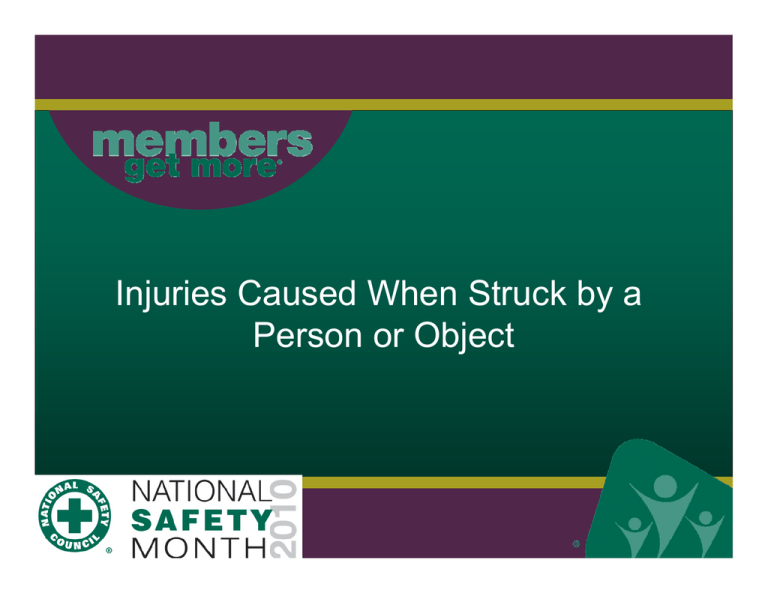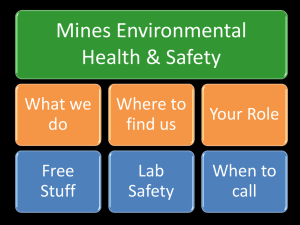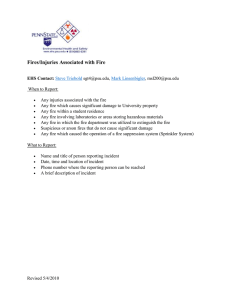Injuries Caused When Struck by a Person or Object
advertisement

Injuries Caused When Struck by a Person or Object Injuries - Struck By or Against Salvatore Caccavale, CPEA Global Senior Manager EHS A.M. Castle & Co. Commitment & Support Assignment of Responsibility Training & Orientation Working Conditions Incident Reporting Emergency Procedures Personal Accountability EHS Philosophies “Sal - osophies” Struck By or Against injuries are the most under rated work place and off the job injury category. Many are fatal Many are life threatening Many incidents deliver serious injuries Many occur with serious property damage The Numbers are Staggering According to the National Safety Council (NSC) Injury Facts (2010 Edition) Struck By/Against Injuries: 2nd leading cause of non-fatal unintentional injuries Leading cause in the 15-24 year old age group 4th leading cause of days away from work cases 4th leading cause of work related deaths Odds of dying on the job by Struck B/A 1 in 1400 Potential Injury Opportunities? Struck By: car, truck, bus, train, boat, golf cart, Golf club, forklift, crane, mobile platform, Bicycle, tire, flying piece of X, garage door, Door opening, rock, another person, mail carrier, Farm equipment, falling objects, motorcycle, Stock items, batted ball, lawn mower, scaffolding, Pressurized hose, hammer head, etc….. Struck Against: car door, piece of protruding X, wall, door, flower pot, office equipment, ladders, Piping, hoses, machinery, fencing, etc….. Some of the Causes? Distractions (on & off the road) cell phone, texting, laptops, TV, I-pod, I-pad Inattention to job surroundings Opening the door Open office equipment (desk/cabinet drawers) Standing up at desk or work station Do WE want Struck By/Against Incidents? Proactive Undesired Event Reactive Controls • Workplace assessments • Job Safety Analysis • Hazard recognition • Incident Investigation (near miss reporting) • Behavioral safety process • Warning devices (audio, visual) • Preventive Maintenance programs Controls • Housekeeping standards • Maintain regulatory compliance • Policies & procedures (workplace violence) • Job skills training (certifications) • Workplace design (engineering) Outline of EHS Process Management Commitment & Support Assignment of Responsibility, Authority & Accountability Maintenance of Safe & Environmentally Sound Working Conditions Training & Orientation Incident Reporting, Analysis & Record Emergency Programs & Procedures Acceptance of Personal Accountability Assessments, Audits & Evaluations • Meeting the Needs of the Organization • Self-Assessments • Third Party Assessments • Reports and Follow-up • Regulatory Assessments Job Safety Analysis A system for the development and use of safe job methods to: • identify and control unsafe job practices before they result in injury/damage • detect hazardous conditions that can be controlled/ eliminated through job modification or engineering controls Job Safety Analysis Everyone involved in the process Department Supervisor - develop Employees - develop Department Head - approve One master copy set of JSA’s Reviewed and/or updated at least every 18 months Job Safety/Hazard Analysis Date Job: Title of Employee Who Does Job: Responsible Supervisor: Author #1 Signature: Department: Section: Author #2 Signature: Required And/Or Recommended Personal Protective Equipment: Approved By: Signature: Sequence of Basic Job Steps Potential Injuries or Hazards Recommended Safe Job Procedure Job Safety Analysis New employee orientation Educate current employees in job hazards Incident Investigation tool Foster employee participation!! Hazard Recognition, Evaluation & Control • Hazard Recognition Job Safety Analysis Safety & Health Inspections Incident Investigations/Reviews • Evaluations Material Safety Data Sheets (MSDS) Industrial Hygiene Exposure Assessment Systems Safety Reviews • Hazard Control Engineering Controls & Redesign Permits Preventive Maintenance Personal Protective Equipment (PPE) Proactive tools for maintaining safe working conditions • • • • • • Pre-Startup Safety Reviews IH exposure assessment Housekeeping inspections Corrective Action Systems Management of Change Project reviews • • • • • • Design concepts Operating procedures Safe work practices Safety & Health procedures Procurement guidelines Mechanical integrity Workplace Design & Engineering • Design and Start-up Review • Ergonomic Factors/ Material Handling • Machine Safeguards • Life Safety Code and Fire Prevention • Flow Diagrams/P&ID’s • Instrumentation and Control • Overpressure Protection • Loss Prevention Aspects “You never know where you’re going ‘til you get there.” Sylvester the Cat Acceptance of Personal Accountability • Accountability (PPE, Procedures, Safety Rules) • Ability to Participate • Observation Programs • Safety and Health Committees • Safety Suggestions • Housekeeping “We are what we repeatedly do. Excellence then is not an act, but a habit.” Aristotle Acceptance of Personal Accountability Managers or Supervisors Role: Maintain - acceptance of personal accountability in those who inherently bring safe behavior to the job Enhance - acceptance of personal accountability in those who allow other priorities to compromise safe behavior Develop - acceptance of personal accountability in those who demonstrate unsafe behavior and continually demonstrate a lack of safety awareness Acceptance of Personal Accountability Supervisor’s Functions Establish work methods Give job instructions Assign people to jobs Supervise people (direct and correct) Maintain equipment and work place All while emphasizing SAFETY! Acceptance of Personal Accountability Leadership Skills Ability to organize and direct activities of others Human behavior (self and others) Leadership (changing face-to-face situations) Emotional control (stress) Practical decision-making (goals based on intelligence) Acceptance of Personal Accountability A - Attitude B - Behavior C - Commitment Barriers to Safe Work Direct Causes Severe Fatigue Illness Intense or Prolonged Stress Alcohol/Drug Use Indirect Causes Workplace Stressors • Shift Schedule • Interpersonal Conflicts • Role Conflicts • Production Schedules • Cultural Change • Unclear Policies Individual Stressors • Family Conflict • Financial Problems • Reaction To Change • Personality Factors Analysis & Correction • Incident Type • Contact by Struck by, against Slip or trip w/o fall Fall from elevation Fall from same level Caught in, under, between Overexertion, strain Transportation Drowning, buried Explosion, implosion Chemicals Electricity Temperature extremes Noise Radiation Animal, insect, plants Analysis & Correction • Personal Factors • Job Factors Lack of knowledge/skill Stress Inadequate capabilities Improper motivation Inadequate Leadership “ Engineering “ Maintenance “ Equipment “ Standards Abuse or misuse Wear & tear Analysis & Correction • Unsafe Behaviors • Unsafe Conditions Failure to Operating without Improper Using defective Making inoperable Inadequate Defective Hazards Exposure Extremes You never get a 2nd chance to make a good 1st impression New Employee Orientation Set aside appropriate amount of time Know what EHS training the person has and needs forklift, mobile platform, etc. Stress how important the EHS process is to you and the organization New Employee Orientation • • • • • • • • General Safety Rules EHS Policy EHS Process Safety Manual Hearing Conservation Housekeeping Incident Reporting Safety meetings • • • • • • • • Reporting hazards Emergency procedures Shift work Heat/cold stress Safety committee PPE - glasses Rx Hazard Communications Equipment specific Attitudes that increase injuries Apathy Carelessness Complacency Defiance Emotion Ignorance Negligence Tiredness “Who cares?” approach to their safety follow safety haphazardly or not at all I’ve never been hurt before on the Job purposely ignore rules & refuse work safely excessive anger/overly upset what you don’t know can hurt you housekeeping, equipment in good repair slows reactions/lowers power of concentration Why employees do not report incidents • • • • • Fear of discipline Concern about record/reputation Fear/dislike of medical treatment Avoidance of red tape Poor understanding of importance Employee Participation • Site safety committees • Program development • Off the job safety • Training Safety Committees Basic Objectives: • Reduce incidence of injuries in workplace • Improve safety in the work environment • provide a means for communication about safety Employees accept personal accountability for safety when they react safely and effectively in the presence of a hazard. Key to the success of any safety process


